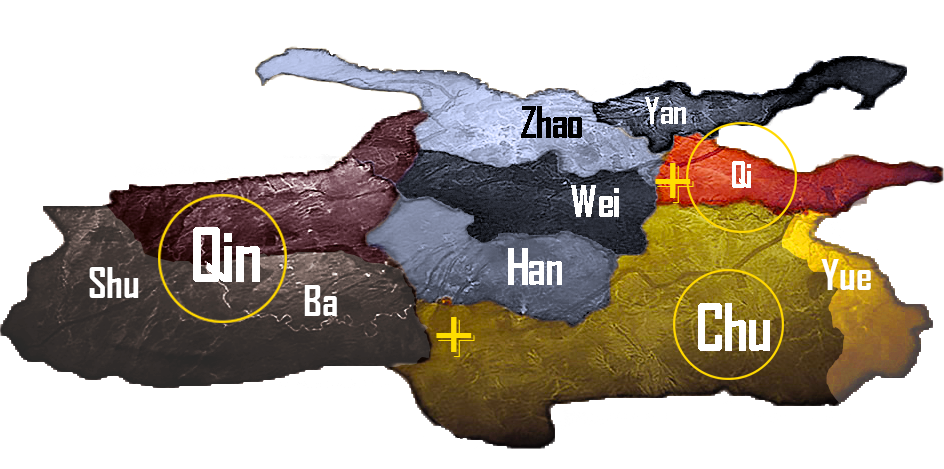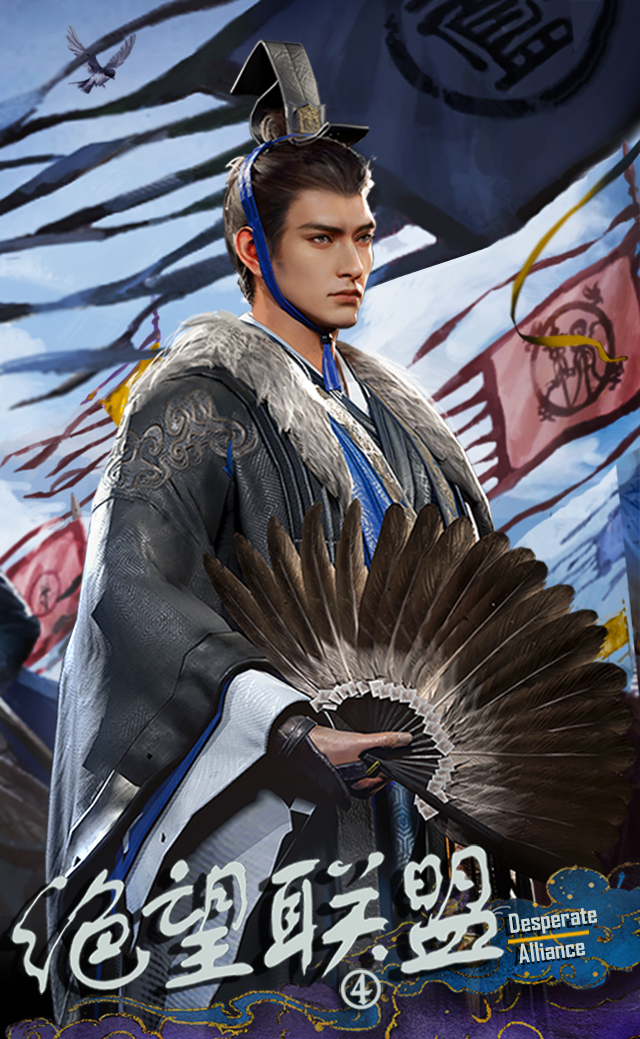Horizontal and Vertical Alliances of the Warring States: 合纵 | 连横
Music: Ambushed from All Sides
This article is an excerpt of a much much longer whole dealing with the great coalitions and diverging Schools of alliances of the Warring States period. The article's length far exists my usual ones and contains about 3 times as much artworks. The link to the article could be found here.
The 2 schools were 2 very different answers to what the ending of the Warring States period will look like. When most of the smaller states have been devoured and only 7 great kingdoms remained, one began to question what the end game of the Warring States will be. Will it be the vertical or the horizontal axis?
"Vertical" and "Horizontal" are not abstractions but "vertical" states (north to south axis of China, most of the 3 former Jin states of Zhao, Wei, Han, plus Yan and Chu) as opposed to the "horizontal" states of either Qin in the west or Qi in the east plus any nations they deem fit to befriend. Qin and Qi at the time were 2 of the strongest kingdoms, the "Vertical and Horizontal Alliances" asks whether the future will belong to a coalition of mutually supporting small states who can hold their own and fend off larger threats together- and let the vertical belt dictate the future, or should the future belong to the great states like Qin and Qi on the east and west.
Coalitions have never been new to this age as great coalitions were formed between lords as soon as Zhou royal power imploded in the early Spring and Autumn era. However once most of the smaller states all disappeared and only 7 great powers remained, the specter of long total war that could last for generations and cause death in millions became an ever more likely reality. Faced with this dreaded reality, the school of Hé zòng 合纵 "Vertical Integration" emerged. The broad term of "School" in this case also included lobbying factions and sympathetic rulers who believes in this political direction. Vertical Integration/ Vertical Alliance seek to rope the remaining vulnerable small states into one unbreakable alliance, with the aid of at least 1 or 2 great powers (either Qin or Qi or Chu) then establish a mutually protective bloc that would be too powerful to challenge, and too well united to be toppled by any single great power's military aggression.
Because most of the states involved are small in size, cooperation, integration are essential for their mutual survival. In fact, this was the recipe of the early success of Wei in the early Warring States period under Marquis Wen and Wu when it reined in Zhao and Han for common purposes. It should be kept in mind this alliance was not designed to be passive and solely defensive either, as the goal of such coalitions is to check and balance nearby great powers. The great Legalist Han Fei referred to these as "Weak Weak Alliances"
When they work together, despite their small sizes they were able to repel much greater foes, so much so that Wei then became a proactive power that stole land from both Qin and Qi. Neither is this form of diplomacy purely defensive nor passive. As Wei in the early Warring States demonstrated, even as 3 small states, the 3 Jins (when aligned) can turn a dangerous position being in the middle of great powers into a proactive staging point for expansion in all directions.
连横 HORIZONTAL ALLIANCE: THE STRONG DO WHAT THEY CAN
Lián Héng 连横 or "Horizontal Connection" is an opposing school that believed the opposite. Rather than believing that the future of the Warring States world would lie in a north- south axis and led by a coalition of mutually reinforcing smaller states, instead the believers of the Horizontal Alliance school- as their names suggested, believed that the future lies in either Qin or Qi (horizontal from the west to east) and that late game of the Warring States lies in either one of them + any states they find useful to rope along.
Horizontal Alliance further encouraged that either Qin or Qi should align with each other- the other great state from afar and take advantage of the weaker small states in the Central Plains. Because the state this philosophy support is strong already, there's much less requirement for complicated binding alliances and coordination between several kingdom's armies.
Tripolar World: Qin (black,) Qi (red,) and Chu (green,) were the 3 major poles of this age and Qin and Chu both had an army around 1,000,000 strong. Caught directly in the middle of the 3 great powers, the Central Plain's states' fortunes would be met with disaster if Qin, Qi and Chu began to align with each other to jointly partition the small Central Plains states. However with this jockeying of the mighty there lies a hidden pole, a 4th pole: the Central Plain states if they could unite as 1 pole (blue.)
The strong do what they can and the weak suffer what they must. Han Fei referred to these as "Strong Strong Alliances" and instances of Strong aligning with a weaker subordinate power as "Weak Strong Alliances."
A MEDITATION ON STATES
Who is greater? A statesman or a general? Looking at the procession of well- remembered fighting men in western history from the likes of Alexander to Hannibal to Napoleon it is easy to correlate that a great dashing master of battles who was able to topple dozens of armies thrown by rival states against them must be greater. However is that assessment really true? Because from the long perspective, each of the figure listed above- despite their resplendent brilliance in battle did not manage to ensure a lasting legacy to passed on their gains to even 1 generation after their own stage exit. Conversely, figures like Augustus and Emperor Wu of Han- who seldom or never led battles in person, were some of the most successful as well as most enduring conquerors. Enduring in that despite not personally acquiring those victories, did manage to make it enduring for centuries across history. It is for these same reason that we must discuss 国 Guo, that is~ "Nation" (or "State") of the Warring States.
A great ruler and statesman~ even if they are not personally exemplary in battle; at their best could be envisioned as some kind of many- armed Hindu god or guardian spirit. Whereby each of the mighty arms (armies) of the state can be expected to reliably deal gory damage to the enemy. In short, like a conductor of a grand orchestra: the best rulers fight with the full might of all of his generals, while backing them with the full apparatus of the great state.
Thus was the 国 state, in all its monstrosity and glory. One is certain to fear and perhaps loath it, but to be without one biased in your favor is to surrender one's ultimate freedom. One only needs to take a look at those unfortunates who were in this very period stripped of that freedom to see what they had lost and would never get back.
MIDGAME ENDS- THE FINAL SCRAMBLE
Woe to the Vanquished: The Last Free Small States- yellow arrows represents expansionary conquests that annexed the last free small states. It was during this time, the climax of the mid Warring States period that all other smaller states disappeared. What's more, all 7 of the major surviving states nearly had all declared themselves kings by this time and their domains a kingdom. In the west, the energetic Qin would soon annexed the underdeveloped states of Shu and Ba, taking the vast fortunes, fields and resources of the Sichuan Basin for its war machine.
In the south, Chu relentlessly ravished the weakened Yue and would soon completely take the east cost for their own, turning their ambitions fully northward. The restrengthened Zhao in the north- with the new mass adoption of true cavalry tactics soon became a resounding conquering power and expanded both east and west, crushing the semi- Sinocized state of Zhongshan and penetrating deep into the steppe lands of today's Inner Mongolia.
Not to be outdone, Chu, Qi, and Wei all scrambled for the last of the ancient states of Lu (by Chu) and in time: Song (by Qi) Very soon, aside from the "7 Heroes" (plus the ceremonial royal domains of Zhou) There are no more other states. When they turn to face each other again, there would no longer be some small border buffer state to gobble, it's just another great power on each of their kingdom's front. Now at each margin of the realm there is a king, and each king a Hegemon in his reach. Perhaps now it is time to ask oneself again, should a strong state be totally feared or even loathed? For what is one's most cherished wishes if they do not have have a kingdom of their own in this grinding of giants?
Read the full article on the School of Alliances to explore how the various geopolitical thinkers and diplomats of this time manuvered the remaining 7 great states into various coalitions and how Qin gamed the system by eeking out an early game advantage that secured its primacy in the late Warring States period and paved the way for the (re)unification of China.
Thank you to my Patrons who has contributed $10 and above: You made this happen!




-%20war.png)




.png)










.jpg)








Comments